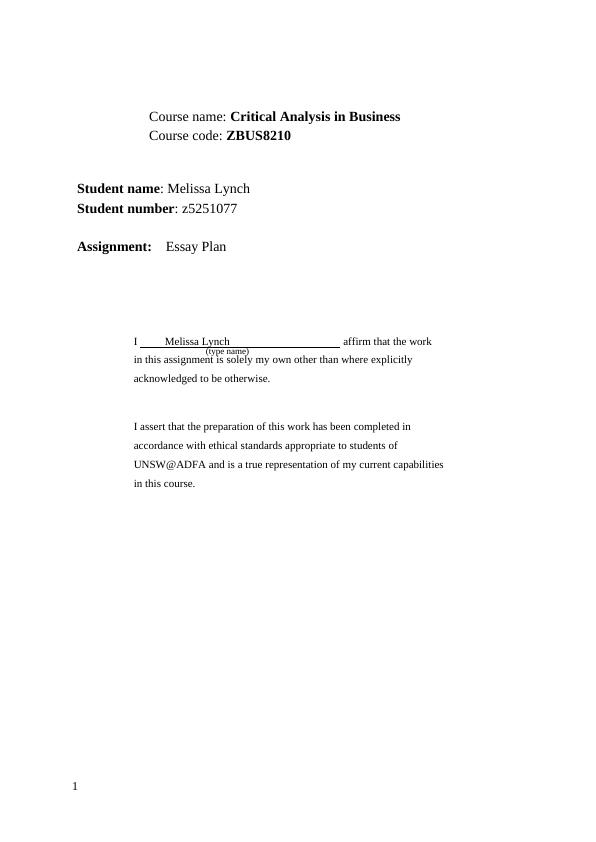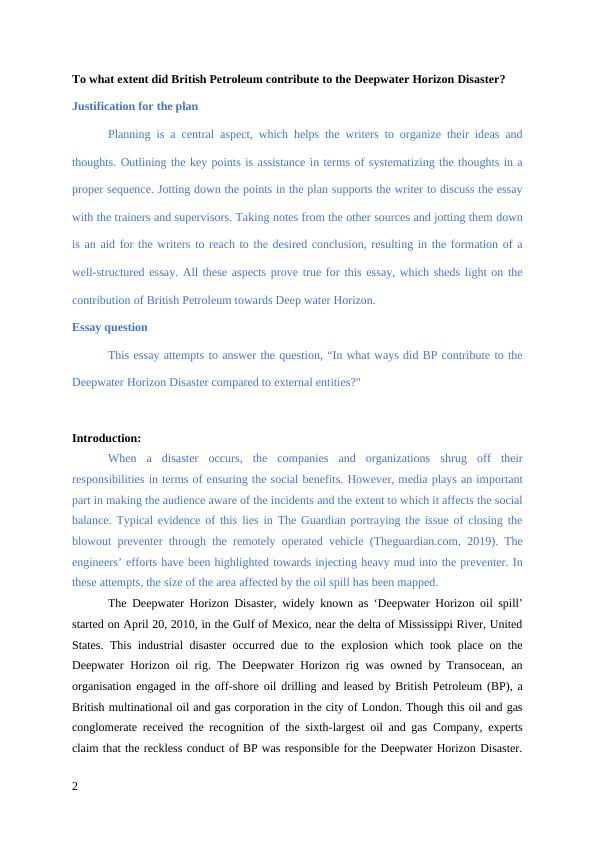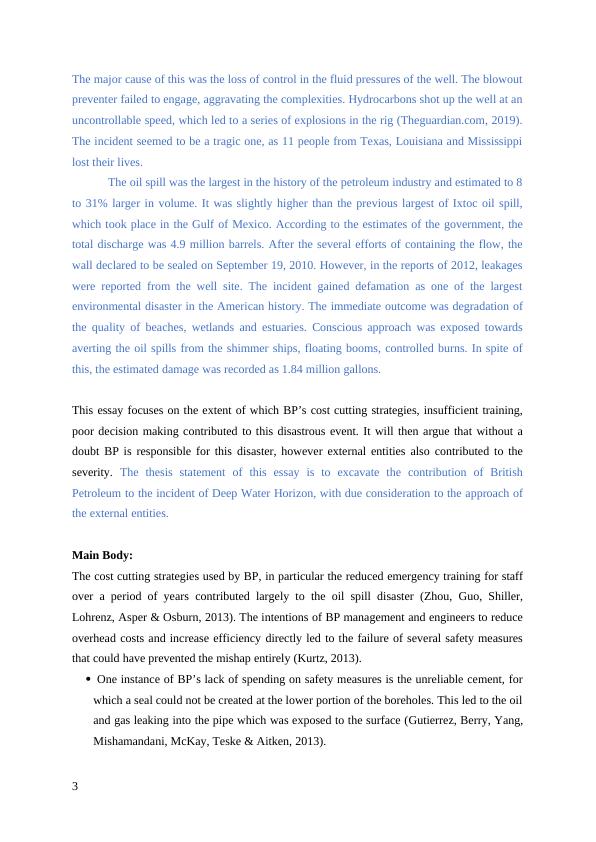Contribution of British Petroleum to Deepwater Horizon Disaster
Added on 2022-12-27
10 Pages3844 Words1 Views
Course name: Critical Analysis in Business
Course code: ZBUS8210
Student name: Melissa Lynch
Student number: z5251077
Assignment: Essay Plan
I Melissa Lynch affirm that the work
(type name)
in this assignment is solely my own other than where explicitly
acknowledged to be otherwise.
I assert that the preparation of this work has been completed in
accordance with ethical standards appropriate to students of
UNSW@ADFA and is a true representation of my current capabilities
in this course.
1
Course code: ZBUS8210
Student name: Melissa Lynch
Student number: z5251077
Assignment: Essay Plan
I Melissa Lynch affirm that the work
(type name)
in this assignment is solely my own other than where explicitly
acknowledged to be otherwise.
I assert that the preparation of this work has been completed in
accordance with ethical standards appropriate to students of
UNSW@ADFA and is a true representation of my current capabilities
in this course.
1

To what extent did British Petroleum contribute to the Deepwater Horizon Disaster?
Justification for the plan
Planning is a central aspect, which helps the writers to organize their ideas and
thoughts. Outlining the key points is assistance in terms of systematizing the thoughts in a
proper sequence. Jotting down the points in the plan supports the writer to discuss the essay
with the trainers and supervisors. Taking notes from the other sources and jotting them down
is an aid for the writers to reach to the desired conclusion, resulting in the formation of a
well-structured essay. All these aspects prove true for this essay, which sheds light on the
contribution of British Petroleum towards Deep water Horizon.
Essay question
This essay attempts to answer the question, “In what ways did BP contribute to the
Deepwater Horizon Disaster compared to external entities?"
Introduction:
When a disaster occurs, the companies and organizations shrug off their
responsibilities in terms of ensuring the social benefits. However, media plays an important
part in making the audience aware of the incidents and the extent to which it affects the social
balance. Typical evidence of this lies in The Guardian portraying the issue of closing the
blowout preventer through the remotely operated vehicle (Theguardian.com, 2019). The
engineers’ efforts have been highlighted towards injecting heavy mud into the preventer. In
these attempts, the size of the area affected by the oil spill has been mapped.
The Deepwater Horizon Disaster, widely known as ‘Deepwater Horizon oil spill’
started on April 20, 2010, in the Gulf of Mexico, near the delta of Mississippi River, United
States. This industrial disaster occurred due to the explosion which took place on the
Deepwater Horizon oil rig. The Deepwater Horizon rig was owned by Transocean, an
organisation engaged in the off-shore oil drilling and leased by British Petroleum (BP), a
British multinational oil and gas corporation in the city of London. Though this oil and gas
conglomerate received the recognition of the sixth-largest oil and gas Company, experts
claim that the reckless conduct of BP was responsible for the Deepwater Horizon Disaster.
2
Justification for the plan
Planning is a central aspect, which helps the writers to organize their ideas and
thoughts. Outlining the key points is assistance in terms of systematizing the thoughts in a
proper sequence. Jotting down the points in the plan supports the writer to discuss the essay
with the trainers and supervisors. Taking notes from the other sources and jotting them down
is an aid for the writers to reach to the desired conclusion, resulting in the formation of a
well-structured essay. All these aspects prove true for this essay, which sheds light on the
contribution of British Petroleum towards Deep water Horizon.
Essay question
This essay attempts to answer the question, “In what ways did BP contribute to the
Deepwater Horizon Disaster compared to external entities?"
Introduction:
When a disaster occurs, the companies and organizations shrug off their
responsibilities in terms of ensuring the social benefits. However, media plays an important
part in making the audience aware of the incidents and the extent to which it affects the social
balance. Typical evidence of this lies in The Guardian portraying the issue of closing the
blowout preventer through the remotely operated vehicle (Theguardian.com, 2019). The
engineers’ efforts have been highlighted towards injecting heavy mud into the preventer. In
these attempts, the size of the area affected by the oil spill has been mapped.
The Deepwater Horizon Disaster, widely known as ‘Deepwater Horizon oil spill’
started on April 20, 2010, in the Gulf of Mexico, near the delta of Mississippi River, United
States. This industrial disaster occurred due to the explosion which took place on the
Deepwater Horizon oil rig. The Deepwater Horizon rig was owned by Transocean, an
organisation engaged in the off-shore oil drilling and leased by British Petroleum (BP), a
British multinational oil and gas corporation in the city of London. Though this oil and gas
conglomerate received the recognition of the sixth-largest oil and gas Company, experts
claim that the reckless conduct of BP was responsible for the Deepwater Horizon Disaster.
2

The major cause of this was the loss of control in the fluid pressures of the well. The blowout
preventer failed to engage, aggravating the complexities. Hydrocarbons shot up the well at an
uncontrollable speed, which led to a series of explosions in the rig (Theguardian.com, 2019).
The incident seemed to be a tragic one, as 11 people from Texas, Louisiana and Mississippi
lost their lives.
The oil spill was the largest in the history of the petroleum industry and estimated to 8
to 31% larger in volume. It was slightly higher than the previous largest of Ixtoc oil spill,
which took place in the Gulf of Mexico. According to the estimates of the government, the
total discharge was 4.9 million barrels. After the several efforts of containing the flow, the
wall declared to be sealed on September 19, 2010. However, in the reports of 2012, leakages
were reported from the well site. The incident gained defamation as one of the largest
environmental disaster in the American history. The immediate outcome was degradation of
the quality of beaches, wetlands and estuaries. Conscious approach was exposed towards
averting the oil spills from the shimmer ships, floating booms, controlled burns. In spite of
this, the estimated damage was recorded as 1.84 million gallons.
This essay focuses on the extent of which BP’s cost cutting strategies, insufficient training,
poor decision making contributed to this disastrous event. It will then argue that without a
doubt BP is responsible for this disaster, however external entities also contributed to the
severity. The thesis statement of this essay is to excavate the contribution of British
Petroleum to the incident of Deep Water Horizon, with due consideration to the approach of
the external entities.
Main Body:
The cost cutting strategies used by BP, in particular the reduced emergency training for staff
over a period of years contributed largely to the oil spill disaster (Zhou, Guo, Shiller,
Lohrenz, Asper & Osburn, 2013). The intentions of BP management and engineers to reduce
overhead costs and increase efficiency directly led to the failure of several safety measures
that could have prevented the mishap entirely (Kurtz, 2013).
One instance of BP’s lack of spending on safety measures is the unreliable cement, for
which a seal could not be created at the lower portion of the boreholes. This led to the oil
and gas leaking into the pipe which was exposed to the surface (Gutierrez, Berry, Yang,
Mishamandani, McKay, Teske & Aitken, 2013).
3
preventer failed to engage, aggravating the complexities. Hydrocarbons shot up the well at an
uncontrollable speed, which led to a series of explosions in the rig (Theguardian.com, 2019).
The incident seemed to be a tragic one, as 11 people from Texas, Louisiana and Mississippi
lost their lives.
The oil spill was the largest in the history of the petroleum industry and estimated to 8
to 31% larger in volume. It was slightly higher than the previous largest of Ixtoc oil spill,
which took place in the Gulf of Mexico. According to the estimates of the government, the
total discharge was 4.9 million barrels. After the several efforts of containing the flow, the
wall declared to be sealed on September 19, 2010. However, in the reports of 2012, leakages
were reported from the well site. The incident gained defamation as one of the largest
environmental disaster in the American history. The immediate outcome was degradation of
the quality of beaches, wetlands and estuaries. Conscious approach was exposed towards
averting the oil spills from the shimmer ships, floating booms, controlled burns. In spite of
this, the estimated damage was recorded as 1.84 million gallons.
This essay focuses on the extent of which BP’s cost cutting strategies, insufficient training,
poor decision making contributed to this disastrous event. It will then argue that without a
doubt BP is responsible for this disaster, however external entities also contributed to the
severity. The thesis statement of this essay is to excavate the contribution of British
Petroleum to the incident of Deep Water Horizon, with due consideration to the approach of
the external entities.
Main Body:
The cost cutting strategies used by BP, in particular the reduced emergency training for staff
over a period of years contributed largely to the oil spill disaster (Zhou, Guo, Shiller,
Lohrenz, Asper & Osburn, 2013). The intentions of BP management and engineers to reduce
overhead costs and increase efficiency directly led to the failure of several safety measures
that could have prevented the mishap entirely (Kurtz, 2013).
One instance of BP’s lack of spending on safety measures is the unreliable cement, for
which a seal could not be created at the lower portion of the boreholes. This led to the oil
and gas leaking into the pipe which was exposed to the surface (Gutierrez, Berry, Yang,
Mishamandani, McKay, Teske & Aitken, 2013).
3

End of preview
Want to access all the pages? Upload your documents or become a member.
Related Documents
Role of BP in Deepwater Horizon Disasterlg...
|9
|2609
|79
Case Study: The Deepwater Horizon Oil Spilllg...
|6
|1080
|179
Critical Analysis of Deepwater Horizon Oil Spilllg...
|17
|5200
|121
Summative Assessment Deepwater Horizon 2022lg...
|14
|3645
|9
Corporate Responsibilitylg...
|6
|1407
|97
Deepwater Oil Spill: Exploring the Causes, Risks, and Response to the Environmental Disasterlg...
|12
|2366
|400